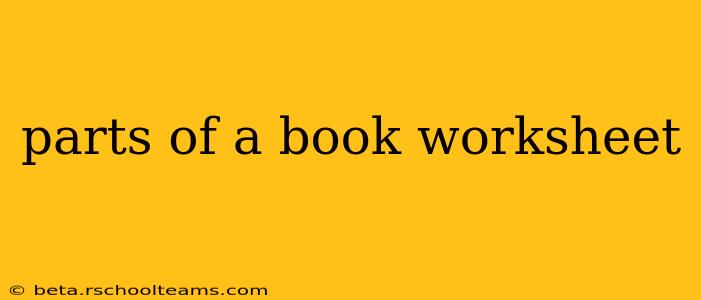Reading a book is more than just turning pages; it's an adventure into a world of words, characters, and stories. But before we dive into the narrative, let's understand the essential components that make up a book. This worksheet will guide you through the different parts, helping you appreciate the structure and artistry involved in creating a published work.
What are the main parts of a book?
A book, at its core, is comprised of several key elements working together to create a cohesive and engaging reading experience. These include:
-
The Title Page: This is the formal introduction to the book, containing the title, author's name, publisher's name, and sometimes the publication date and edition number. Think of it as the book's official identification card!
-
The Table of Contents: This acts as a roadmap for your reading journey. It lists the chapters, sections, or parts of the book, along with their corresponding page numbers, allowing you to quickly locate specific information.
-
The Preface or Foreword: These sections often appear at the beginning and provide context or background information. A preface is usually written by the author, offering insights into the book's creation or purpose. A foreword is written by someone other than the author, often an expert in the field, lending credibility and offering a different perspective.
-
Chapters: These are the building blocks of the narrative. They divide the story into manageable sections, each contributing to the overall plot and character development.
-
Illustrations/Images (if applicable): Many books, particularly children's books and non-fiction works, incorporate visuals to enhance understanding and engagement. Illustrations can be photographs, drawings, charts, or graphs.
-
The Epilogue: (Not always present) This section appears after the main story concludes and offers a glimpse into the future of the characters or events, providing a sense of closure or hinting at further possibilities.
-
The Index (for non-fiction): A crucial element in non-fiction books, the index allows readers to quickly find specific topics or terms mentioned within the text. It's an alphabetical listing of keywords and page numbers.
Frequently Asked Questions (FAQ) about Book Parts
What is the difference between a preface and a foreword?
The key difference lies in the author. A preface is written by the book's author, offering personal insights into their work. A foreword, however, is written by someone else, often an expert or respected figure in the relevant field, providing an endorsement or alternative perspective.
What is the purpose of a table of contents?
The table of contents serves as a navigation tool, helping readers quickly find specific sections or chapters within the book. This is particularly useful for longer or more complex works.
Do all books have an epilogue?
No, not all books include an epilogue. Epilogues are often found in novels or narratives that aim to offer a sense of resolution or closure beyond the main storyline. Many non-fiction books do not have epilogues.
Why are illustrations important in some books?
Illustrations enhance the reader’s understanding and enjoyment, especially in books for children or those dealing with complex topics. They can make the text more visually appealing and easier to comprehend.
How can I use the index effectively?
The index is your best friend when searching for specific information in a non-fiction book. Use keywords or key phrases to quickly locate relevant passages and page numbers.
Activity: Book Part Identification
Choose a book you have readily available. Identify and describe the following parts:
- Title Page: Write down the title, author's name, and publisher.
- Table of Contents: How many chapters are there? What is the title of Chapter 3?
- Preface or Foreword (if present): Who wrote it? What was the main point?
- Illustrations (if present): What kind of illustrations are used? How do they enhance the book?
- Index (if present): How is the index organized? What is one topic that's included in the index?
By completing this worksheet, you'll develop a more profound understanding of the intricate parts that work together to create a compelling and well-structured book. Happy reading!
